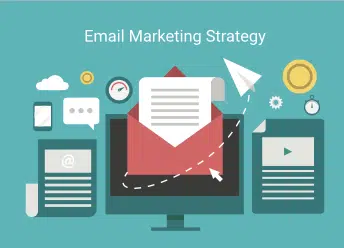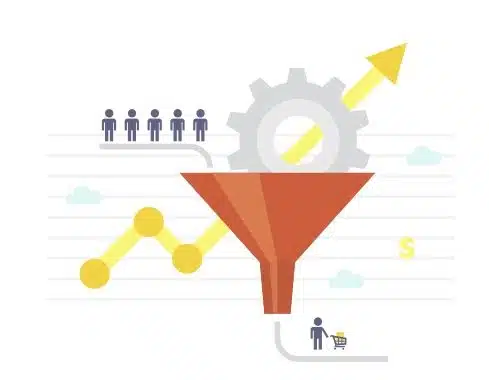
By now, you can pretty well assume that the vast majority of your business customers and prospects have email service providers and regularly send and receive digital messages. This is true regardless of whether you seek a B2B or B2C audience or are looking for clients, customers, supporters, or any other class of respondents.
That’s why email marketing is a strategy that can deliver impressive results at an excellent return on investment. But only if it’s done right. At 800.com, we’re happy to offer basic guidance on email marketing strategies that will work effectively even for beginners.
Here are what we consider to be some of your key moves on that first campaign.
Create a Map to Conversion
This is just another way of saying that you must know what you’re trying to do before you try to do it.
If you’re offering a low-cost impulse buy, maybe it’s realistic to expect a certain number of respondents to make a purchase decision with only one or two contacts.
However, if you’re selling a big-ticket item, a complex B2B service contract, or other costly goods or services, you need to move email recipients from prospects to customers along a more complex path. Your initial call to action might simply be to get the respondent to subscribe to a podcast or a digital newsletter.
From there, you move the prospect into your sales funnel toward an eventual purchase and long-term relationship.
The point here is that you start by establishing realistic response goals, and set up your email marketing campaign to convert your recipients to the next step in the digital marketing process.
Develop an Organic Subscriber List
It’s easy to get thousands or even millions of email addresses. You can buy such a list for a fraction of pennies per contact. But that might only hurt your cause.
The problem is, every recipient is used to skimming through junk email. If your mailing looks irrelevant to their needs, your email will be deleted, unopened and unread. But your effort is potentially more than merely wasted. Email service providers like Google filter out e-mailers as spam based on a number of factors, including open rates. So if your email is going ignored by a high percentage of your recipients, all of your future mailings might end up in the system’s spam folder.
When we talk about an organic list, it consists of recipients who either opted in to receive your mailings or those with whom you’re already established a business relationship. These contacts are likelier to view your communications as being relevant to their needs and that will increase the likelihood that they open and potentially respond to your communications.
Strategically Boost Your Open Rates
Your open rates measure the percentage of recipients who actually open and (presumably) read your emails. Keep in mind, whether you’re targeting a business or consumer audience, your recipients are busy. And they’re used to digital junk in their inboxes. It’s quick and easy to clean up such clutter by dumping your email, unread. That’s why first impressions are so important.
Your most basic first impression comes from your subject line. Make sure it doesn’t come across as schlocky with words like “Free” and “Miracle,” with lots of all-caps and exclamation points. Such subject line language and presentation is another way email service providers filter emails to spam folders. And even if yours does make it to your recipients, they’re unlikely to think such an email is much more than a waste of their time.
Keep your subject lines clear and focused, simple and direct. Don’t overpromise or sound over-promotional. Keep the end-user in mind and remember what you want them to do. Think of your subject line as your billboard. As your audience whizzes down the highway at 60 miles an hour, they’ll only take notice if your outdoor advertising is short, blunt, to the point and relevant to their needs.
Same with your email marketing subject line. It might be hard initially defining which subject lines work for your business and which don’t-but that’s where A/B testing comes into the picture. Try different approaches, and then measure open rates. You can quickly figure out what works and what copy strategies need to be dumped.
Pull Window Shoppers into Your “Store”
Let’s say you’re strolling through a shopping mall. You see a store with an intriguing sign and the possibility that the shop carries merchandise you’re interested in. So you walk in and see a cheap-looking interior with a mishmash of products cluttering aisles and weird smells in the air. You execute a U-turn and head for the door.
It’s the same with your email marketing campaign. Your subject line and the relevancy of your list might yield impressive (or at least acceptable) open rates, but that’s only your first metric of success. Once your recipients have opened your email, you want them to stay awhile. You want them to click-through.
Click-through rates (CTR) measure the percentage of recipients who read your messaging and click the link you provide in order to take the next step. To get to that expected response, you’ve got to first interest your recipients in actually reading and thinking about your communication. That’s done by providing messaging that looks as appealing as it reads.
Don’t make your respondents overwork. Here are some of the ways that they might struggle to get through your mailing (or, more likely, abandon the effort to do so):
- Make the messaging boring, confusing and disorganized.
- Be sure the type is hard to read.
- Make large, clunky blocks of copy that look intimidating or hard to get through.
- Hide the response button or link so your readers have no idea what you want them to do.
- Write so much copy that the reader must scroll down, down, down, with no idea when it’s going to end or what they’re supposed to do once they finally get to the end.
- Make sure the email design is ugly and uninviting.
As you can see, it’s easy to create an email that will turn off your audience as quickly as a cluttered and disorganized store layout will chase away brick and mortar customers. But doing the opposite-writing clear and concise messages in a clean and appealing layout with your call to action clearly spelled out-can turn your window shoppers into real prospects.
To put it another way, those who open your emails will actually read them and possibly even take the action you ask them to take if the presentation is professional, clearly stated and inviting.
Segment Your Audience
Your recipients will move along your sales funnel at different rates of speed. Some will show more interest in one product offering than others. Some are already avid customers while others might not have even heard of your company yet.
Just as you’ve found in other ways of marketing your product or service lines, no two customers or prospects are the same. Your salespeople are trained to ask questions first that indicate the direction their presentation should take, and to not have a standard pitch for everyone.
Mailing list segmentation is about creating as many separate lists as you need to tailor your messaging to meet unique customer needs. This keeps everyone from feeling you’re simply sending out a boilerplate copy.
Sending an “about us” introductory email to a long-time and loyal client will sound impersonal and insulting. By segmenting your recipients into separate email lists, you can avoid that kind of faux pas.
Don’t Bombard Anyone
Probably the best way of earning an unsubscribe request is to bombard recipients with messaging. As we’ve said repeatedly, your audience receives no shortage of email in their home or work inboxes. Even if your mailings are relevant to each member of your target audience, too much is too much.
So how is “too much” defined? Unfortunately, many advertisers find that out the hard way-with unsubscribing orders from recipients who will never opt-in again. If you must err, do it on the side of too few mailings. Only communicate when you have real and relevant information to share: special sales, new product launches, big corporate news, or other content to the actual benefit of recipients.
If they do unsubscribe, try soliciting a reason. If your survey finds that most quit you because of too many mailings, that will help you adjust the frequency.
Test, Test, Test
The great thing about digital marketing is that you can fail fast. If your email marketing campaign is not working, you can tweak subject lines, messaging, design calls to action, or other elements that might not be working.
Your primary metrics of email marketing success will be open rates and click-through rates. From there, you can measure other components of the digital campaign until you see the conversion numbers you want.
Your A/B testing should be an ongoing campaign strategy. Never assume that you “finally” got the campaign right, and no future testing is needed.
Call 800.com
At 800.com, we help digital advertisers make impressive gains. We focus on calls to action that include toll-free vanity phone numbers that reflect your company’s theme or messaging and are easy for your customers to recall.
Whatever your email marketing strategy, make vanity phone numbers from 800.com integral to your efforts. We’ll show you how. Visit 800.com or call us at (800) 800-4321.





